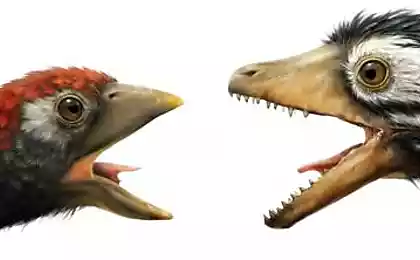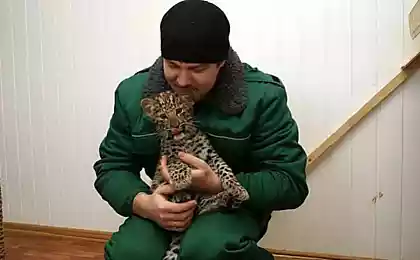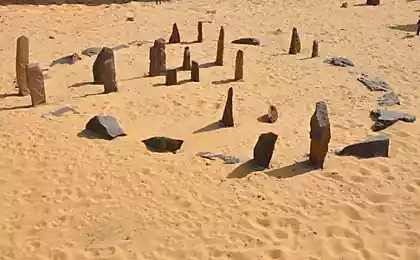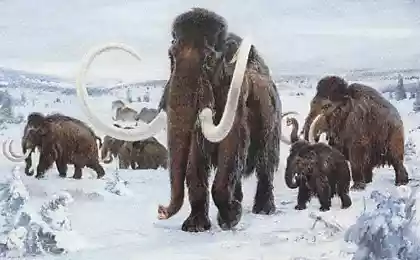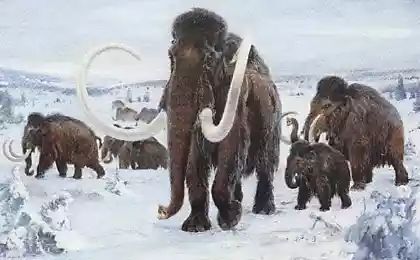3250
The giants of the world of mammals.
Continuing the theme.
Bats (Chiroptera) - the only order of mammals, representatives of which are capable of active flight. This second largest (after the rodents) squad includes 1200 species. The largest of them has long did not live in caves, and in the forests, where fossil remains poorly maintained, and the largest representative we have one modern - maned atserodon (Acerodon jubatus), which can grow up to 2 meters in wingspan and weigh more than 1.5 kg. Harmless fruit-eating endemic to the Philippines.
25 photos.
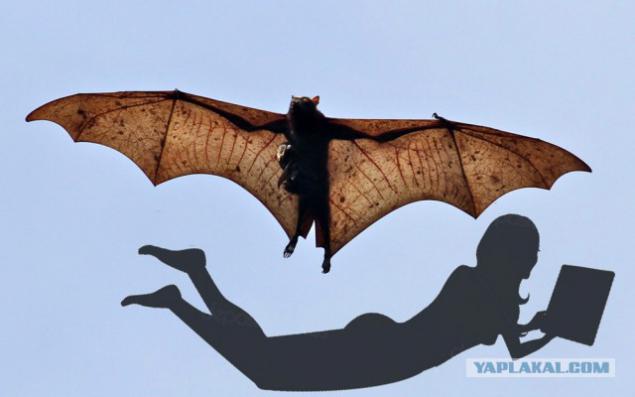
Insectivores (Insectivora) - hedgehogs, moles, shrews, SOLENODON - traditionally squad, but in fact paraphyletic, ie the collective groups of animals that have preserved the most archaic structure has changed little since the time of the dinosaurs. Looking at them, it is possible to imagine a common ancestor of all animals, which will be discussed in this part. Giants not among them, but as an example I would like to mention chuchundru - remember Kipling, who could not reach the middle of the room? So this is a real animal, but not a rat, and a giant white-toothed shrew (Suncus murinus, chuchundar), it is found in India and Southeast Asia. Well, for a giant white-toothed shrew - 20-23 cm in length including the tail.

Name superorder laurasiatheria (Laurasiatheria) is based on the common origin of the related mammals somewhere with Laurasia - they all came from some fortunate populations of animals living on this ancient continent where some 95 million. Years ago and spread in the beginning, even when dinosaurs , in the Northern Hemisphere, and from there moved on to conquer the rest of the planet.

Troop tsimolestov (Cimolesta, which means "the kidnappers white clay") was considered extinct in the Miocene, giving to this as a side branch of the beginning of the ancestors of prey and creodonts, but recent genetic studies have shown that it is treated today pangolins, traditionally singled out squad The largest of these scaly ant-eaters - a giant pangolin (Manis gigantea), live in Africa. Length of 140 cm, weighing up to 33 kg. In the old days tsimolesty were no less bizarre, and the largest of the known was barilyambda (Barylambda faberi) from the Paleocene (60-56 million years ago) in North America. Length of the herbivorous 2 was about 5 m, a weight of about 650 kg.

Dinocerata (Dinocerata) - an extinct order of mammals, who lived on the Upper Paleocene to Middle Eocene (59-41 million years ago) in North America and Asia. One of the first large mammals that have appeared since the time of the extinction of the dinosaurs. A sort of test, an alpha version of ungulates, leaving no descendants. The biggest of them is uintatherium Uintatherium anceps height of 1, 50 m at the withers, about 3, 3 meters long, lived in the Middle Eocene in North America.
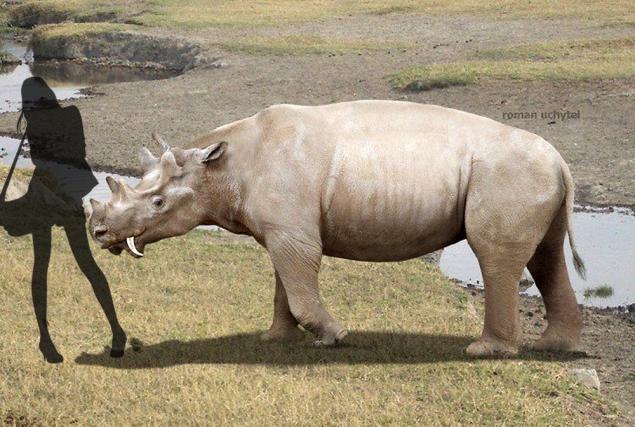
Mesonychid (Mesonychia) - another extinct order of mammals, hoofed carnivores peculiar origin. The largest of these, and at the same time the largest land predator of mammals was andrewsarchus Andrewsarchus mongoliensis of Mongolia Upper Eocene (45-36 million years ago). 3, 4 meters in length without tail (tail all 5) 1, 5 m and the withers of 800-900 kg body weight.
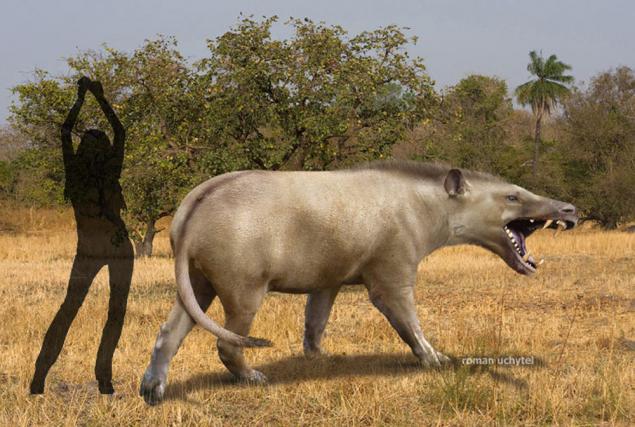
Creodontas (Creodonta) - extinct carnivorous mammals detachment of which I spoke here. The largest of them was the remains megistotherium Megistotherium osteothlastes weighing about 880 kg, a length of more than 3, 5 meters and a length of 65 cm skull. He lived in the Middle Miocene (12 million years ago) in the territory of present Egypt, Libya and Kenya.
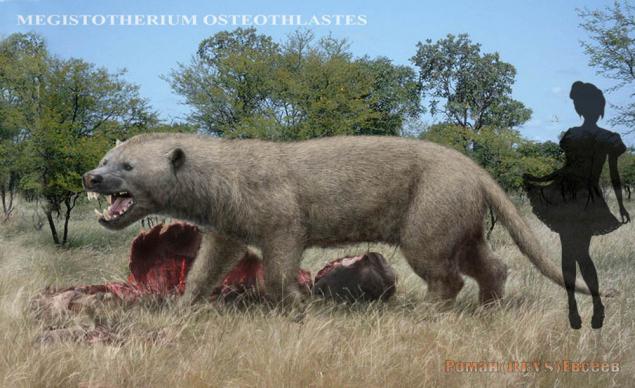
Next will detachment of predators (Carnivora). Cat family (Felidae) needs no introduction, and contains as many as three champions: the largest of the modern tiger (Panthera tigris), the Amur subspecies which grows up to 3, 3 meters long, 1 to 2 m at the shoulder and is now eating up to 300 kg; American extinct subspecies of lion (Panthera leo atrox) - 3, 7 meters in length overall, and as the saber-toothed Smilodon ropulator with 470 kg as the most massive.

Hyenas (Hyaenidae) - terrific predators suborder feliformia (not to be confused with the family cat!), Convergent similar to dogs as genetically close to civets. The largest sea today is the spotted hyena (Crocuta crocuta), reaching up to 1, 5 - 1, 6 m in length, at the height of the shoulders 90 cm, and the biggest in the history was the 190-pound short face hyena Pachycrocuta brevirostris, lived in Europe between 1 and 6 and 0, 5 million. years ago and performs there the same biological role as a modern spotted her sister in Africa.

Perkrokutidy (Percrocutidae) - like hyenas predators living in Asia, Africa and Southern Europe with the Miocene of the Pliocene (about 20-2.59 million years ago). However, they were in a closer relationship with koshkopodobnymi nimravidae than with much more similar to these hyenas. These hyenas they apparently were driven out. The largest size reached Dinocrocuta gigantea,
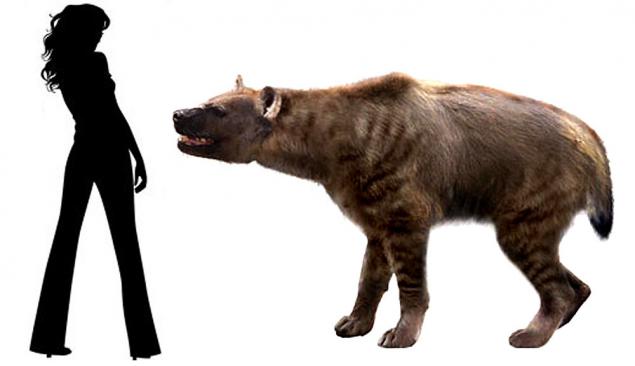
The canine (Canidae) for the title of the largest species compete homemade dog (Canis lupus familiaris) and extinct Epicyon haydeni, who lived between 10 and 13 million. Years ago in North America. Epicyon was 2, 4 meters in length and weighing over a hundred.
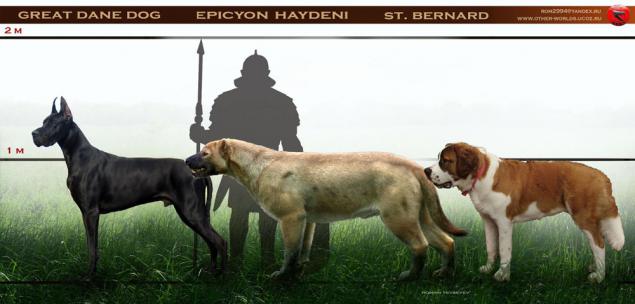
The largest representative of the bear (Ursidae) and largest land predator of our time - the polar bear (Ursus maritimus). Its length is 3 m, weight up to 1 ton. The biggest bear of all time - Arctotherium angustidens - bear about 3 to 5 m in length from the Pleistocene (2 million-10 thousand. Years ago) .Yuzhnoy America.
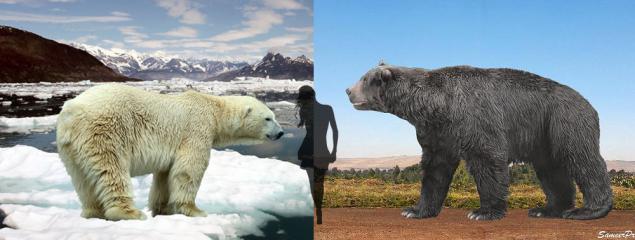
Family coon (Procyonidae) today can not boast of giants. But the ancestors of bears in the previous section, coming from North America to South, to all appearances, competitively wiped Chapalmalania altaefrontis - giant (meter at the withers), raccoon, who lived there between 5.3 and 1.8 million. Years ago).

Pinnipeds (Pinnipedia) previously accounted for one unit together, and now understood that it is three different families caniformia independently acquired a similar structure as a result of the transition to an aquatic lifestyle - these seals (Phocidae), walruses (Odobenidae) and eared seals (Otariidae). The largest representatives of all three families live in the moment. It accordingly southern elephant seal (Mirounga leonina, 6, 9 mx 5m), walruses (Odobenus rosmarus, 4, 9 mx 2m) and civuch (Eumetopias jubatus, 3, 5 meters x 1t).
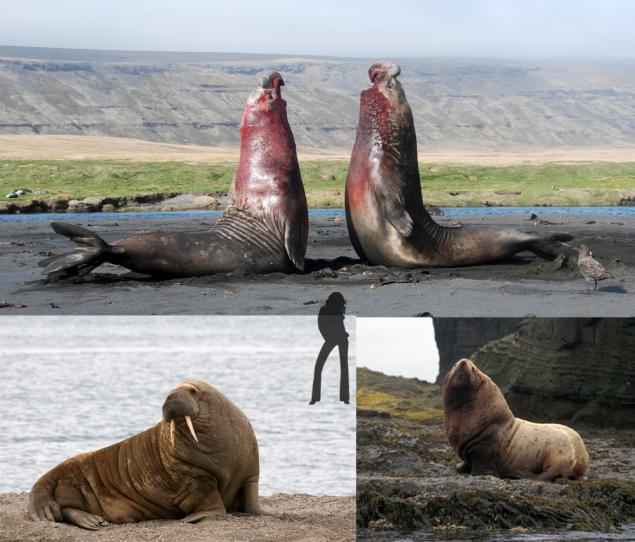
This predatory everything go to the order Perissodactyla (Perissodactyla). Brontoterievye (Brontotheriidae) - an extinct family of equines living with Eocene to early Oligocene. Despite the similarity with the rhinos were closer in kinship to the horses, and the horn on the nose they had not keratin and outgrowths of the nasal bones of the skull, and were not as many weapons as snorkel when feeding marsh vegetation and the resonating chamber. The largest of these was embolotery (Embolotherium sp.), Who lived in what is now the Gobi desert 50 million. Years ago. It was around 2 to 5 m at the shoulder and weighed about 2000 kg.
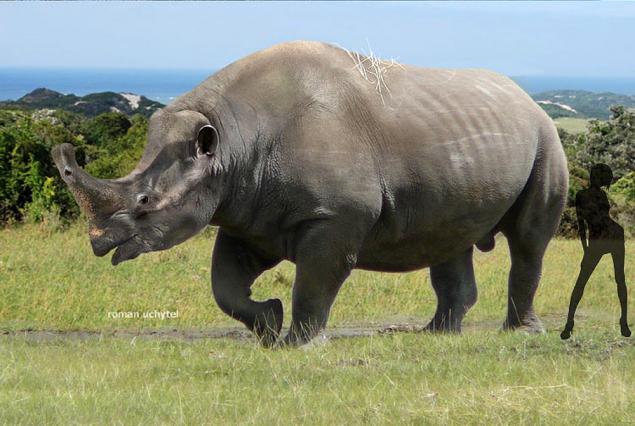
As for the rhinoceros (Rhinocerotidae), they are due to the white rhino (Ceratotherium simum) now rank second largest land animal on the planet after the elephant. Massa old males can reach 5 tons, length - 4, 2 m height at the shoulders - 2 m. The largest rhino ever - elasmotery Elasmotherium caucasicum, lived in Eurasia since the Pliocene of the Pleistocene, up to 6 m, a height of 2, 5 m.
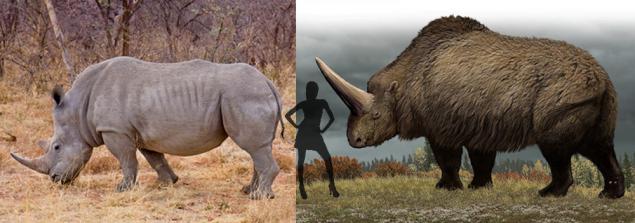
Close to the rhinoceros family - girakodontovye (Hyracodontidae). Most of them were small hornless creatures with a slight physique and resembles a small horses, but this family has the largest land mammal of all time - paraceratherium Paraceratherium tienshanense. This beauty height at withers up to 5, 5 m, 9 m long and weighing about 15 tons. Lived in the Oligocene in Asia between 33 and 23 million years ago.
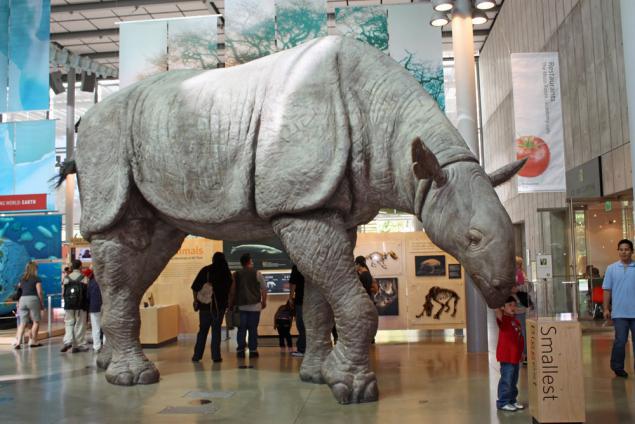
On the example of the horse family (Equidae) very good exhibit a consistent evolution - its representatives within 55 million years, gradually and consistently lost their extra toes on their feet and have grown by 20-centimeter Hyracotherium (a common ancestor with paraceratherium) to own horses in full size. Further, the process of people intervened, as a result, we have the domestic horse (Equus ferus caballus) as the largest representative of the family. The historical record of growth belongs born in 1850, Samson later pereimennovannomu in Mammoth, the growth of which reached 218 cm at the withers, and of living the highest horse in the world is English Heavy Noddy height of 2, 05 meters at the shoulder and weighing half a ton.

Another related family of horses - halikoterievye (Chalicotheriidae) - represented by strange creatures who lived on the Eocene to the Pliocene (40-3, 5 million years ago). Fingers them, despite belonging to the order Perissodactyla, bore not the hoof, and thick claws. Some of them are mined from the earth roots and tubers, while others feed on the leaves, legs bending the branches of trees. Their sizes ranged from sheep comparable to 2, 7-meter at the withers halikoteriya Chalicotherium sp.
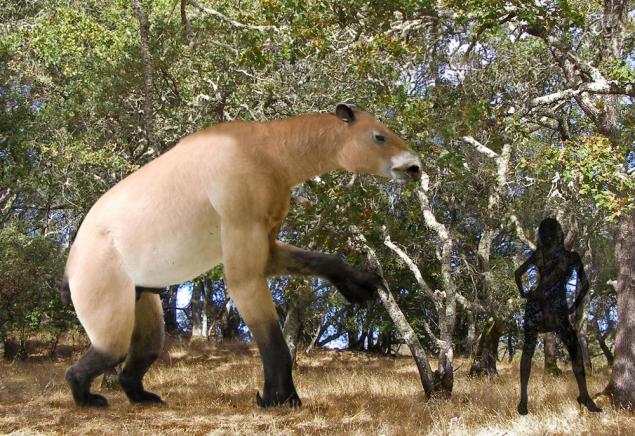
We turn to the artiodactyl. The family bovids (Bovidae) are buffaloes, antelopes and other goats - those ruminants who have horns straight, non-removable cover and covered with horny. Today, the largest cow - a gaur (Bos frontalis). The length of his body more than three meters, the height at the shoulder reaches 2 to 3 m, and the weight can sometimes reach 2000 kg. Pleistocene giant American bison (Bison latifrons) was as much as five meters long and weighed two tons of the same, on average, not as a record. The distance between the tips of its horns 2, 5 m

Representatives of the deer family (Cervidae) have branched regularly discharged and the horns grow back again, usually growing only in males. In the most primitive representatives of horns there, but there fangs. Today, the largest deer - a moose (Alces alces) - body length of up to 3 m, height is up to 2, 3 m, weight up to 600 kg. But Thranduil in Peter Jackson - remember yourself and tell all your friends! - I sat on horseback than on what is not on the elk, and deer megalotserose or bolsherogom (Megaloceros giganteus). This wiped out by man in the Pleistocene the largest representative of the family in size resembled a moose, but weighed about 750 kg, and the horns of it reached 3, 65 m in width. Its range covers much of Eurasia, from Western Europe to western China.
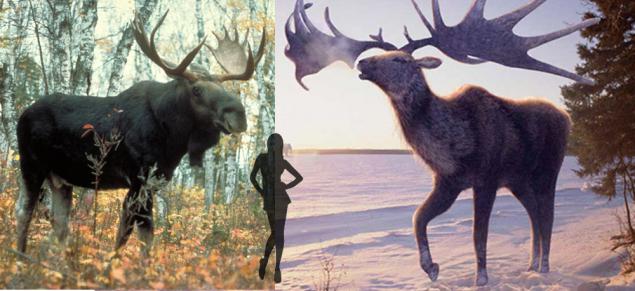
The family of camelids (Camelidae) today, numerous, and the largest of its representative - dromedary (Camelus dromedarius) about 2 m in height at the withers and weighing 600 kg. The giant camel (Titanotylopus nebraskensis), who lived 10, 3-1, 8 million years ago in North America, was 3, 5 m in height at the withers, 5 m in length and weighed about 2 tons.
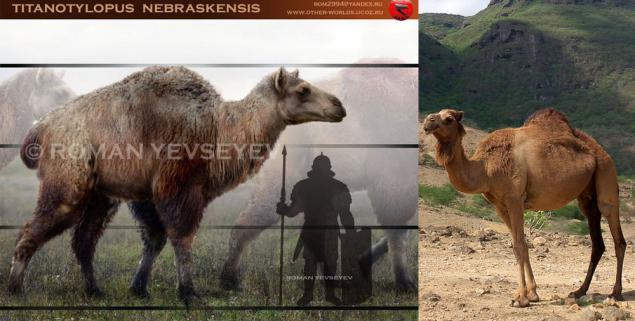
Giraffidae (Giraffidae) - a family of cloven-hoofed animals, currently found only in Africa and contains two kinds, in which there is one species: a giraffe (Giraffa camelopardalis) and the okapi. The first - the tallest mammal date and the largest member of the family history.

Treasure Suoidea includes family Suidae (Pigs), Tayassuidae (Pekarievye) and Entelodontidae (entelodont). The largest member of the family present, as you might guess - a subspecies of the wild boar domestic pig (Sus scrofa domesticus), some individuals that can reach a ton of weight or more. The Miocene in North America lived Daeodon shoshonensis - Representative entelodont height of 3, 4 meters long, 2, 4 meters tall at the shoulder and weighing 900 kg.

Family Begemotova (Hippopotamidae) previously attributed to the suborder svinoobraznyh or non-ruminants, but from the point of view of cladistics they are closer to the whales and ruminants, rather than to pigs. Today, the biggest behemoth - ordinary (Hippopotamus amphibius), up to 3 m in length, 1, 65 m at the shoulder and weighs sometimes more than 4 tons. But that's not the ways of God - in the Pleistocene lakes of Western Sahara was driven Hippopotamus gorgops length of 4, 3 meters . But with the mind - hippo hippopotamus.
And still we have a detachment of cetaceans (Cetacea), comprising at least 14 families, which we will devote a separate part - they are worse than the sauropods in the end?
via

Source:
Bats (Chiroptera) - the only order of mammals, representatives of which are capable of active flight. This second largest (after the rodents) squad includes 1200 species. The largest of them has long did not live in caves, and in the forests, where fossil remains poorly maintained, and the largest representative we have one modern - maned atserodon (Acerodon jubatus), which can grow up to 2 meters in wingspan and weigh more than 1.5 kg. Harmless fruit-eating endemic to the Philippines.
25 photos.

Insectivores (Insectivora) - hedgehogs, moles, shrews, SOLENODON - traditionally squad, but in fact paraphyletic, ie the collective groups of animals that have preserved the most archaic structure has changed little since the time of the dinosaurs. Looking at them, it is possible to imagine a common ancestor of all animals, which will be discussed in this part. Giants not among them, but as an example I would like to mention chuchundru - remember Kipling, who could not reach the middle of the room? So this is a real animal, but not a rat, and a giant white-toothed shrew (Suncus murinus, chuchundar), it is found in India and Southeast Asia. Well, for a giant white-toothed shrew - 20-23 cm in length including the tail.

Name superorder laurasiatheria (Laurasiatheria) is based on the common origin of the related mammals somewhere with Laurasia - they all came from some fortunate populations of animals living on this ancient continent where some 95 million. Years ago and spread in the beginning, even when dinosaurs , in the Northern Hemisphere, and from there moved on to conquer the rest of the planet.

Troop tsimolestov (Cimolesta, which means "the kidnappers white clay") was considered extinct in the Miocene, giving to this as a side branch of the beginning of the ancestors of prey and creodonts, but recent genetic studies have shown that it is treated today pangolins, traditionally singled out squad The largest of these scaly ant-eaters - a giant pangolin (Manis gigantea), live in Africa. Length of 140 cm, weighing up to 33 kg. In the old days tsimolesty were no less bizarre, and the largest of the known was barilyambda (Barylambda faberi) from the Paleocene (60-56 million years ago) in North America. Length of the herbivorous 2 was about 5 m, a weight of about 650 kg.

Dinocerata (Dinocerata) - an extinct order of mammals, who lived on the Upper Paleocene to Middle Eocene (59-41 million years ago) in North America and Asia. One of the first large mammals that have appeared since the time of the extinction of the dinosaurs. A sort of test, an alpha version of ungulates, leaving no descendants. The biggest of them is uintatherium Uintatherium anceps height of 1, 50 m at the withers, about 3, 3 meters long, lived in the Middle Eocene in North America.

Mesonychid (Mesonychia) - another extinct order of mammals, hoofed carnivores peculiar origin. The largest of these, and at the same time the largest land predator of mammals was andrewsarchus Andrewsarchus mongoliensis of Mongolia Upper Eocene (45-36 million years ago). 3, 4 meters in length without tail (tail all 5) 1, 5 m and the withers of 800-900 kg body weight.

Creodontas (Creodonta) - extinct carnivorous mammals detachment of which I spoke here. The largest of them was the remains megistotherium Megistotherium osteothlastes weighing about 880 kg, a length of more than 3, 5 meters and a length of 65 cm skull. He lived in the Middle Miocene (12 million years ago) in the territory of present Egypt, Libya and Kenya.

Next will detachment of predators (Carnivora). Cat family (Felidae) needs no introduction, and contains as many as three champions: the largest of the modern tiger (Panthera tigris), the Amur subspecies which grows up to 3, 3 meters long, 1 to 2 m at the shoulder and is now eating up to 300 kg; American extinct subspecies of lion (Panthera leo atrox) - 3, 7 meters in length overall, and as the saber-toothed Smilodon ropulator with 470 kg as the most massive.

Hyenas (Hyaenidae) - terrific predators suborder feliformia (not to be confused with the family cat!), Convergent similar to dogs as genetically close to civets. The largest sea today is the spotted hyena (Crocuta crocuta), reaching up to 1, 5 - 1, 6 m in length, at the height of the shoulders 90 cm, and the biggest in the history was the 190-pound short face hyena Pachycrocuta brevirostris, lived in Europe between 1 and 6 and 0, 5 million. years ago and performs there the same biological role as a modern spotted her sister in Africa.

Perkrokutidy (Percrocutidae) - like hyenas predators living in Asia, Africa and Southern Europe with the Miocene of the Pliocene (about 20-2.59 million years ago). However, they were in a closer relationship with koshkopodobnymi nimravidae than with much more similar to these hyenas. These hyenas they apparently were driven out. The largest size reached Dinocrocuta gigantea,

The canine (Canidae) for the title of the largest species compete homemade dog (Canis lupus familiaris) and extinct Epicyon haydeni, who lived between 10 and 13 million. Years ago in North America. Epicyon was 2, 4 meters in length and weighing over a hundred.

The largest representative of the bear (Ursidae) and largest land predator of our time - the polar bear (Ursus maritimus). Its length is 3 m, weight up to 1 ton. The biggest bear of all time - Arctotherium angustidens - bear about 3 to 5 m in length from the Pleistocene (2 million-10 thousand. Years ago) .Yuzhnoy America.

Family coon (Procyonidae) today can not boast of giants. But the ancestors of bears in the previous section, coming from North America to South, to all appearances, competitively wiped Chapalmalania altaefrontis - giant (meter at the withers), raccoon, who lived there between 5.3 and 1.8 million. Years ago).

Pinnipeds (Pinnipedia) previously accounted for one unit together, and now understood that it is three different families caniformia independently acquired a similar structure as a result of the transition to an aquatic lifestyle - these seals (Phocidae), walruses (Odobenidae) and eared seals (Otariidae). The largest representatives of all three families live in the moment. It accordingly southern elephant seal (Mirounga leonina, 6, 9 mx 5m), walruses (Odobenus rosmarus, 4, 9 mx 2m) and civuch (Eumetopias jubatus, 3, 5 meters x 1t).

This predatory everything go to the order Perissodactyla (Perissodactyla). Brontoterievye (Brontotheriidae) - an extinct family of equines living with Eocene to early Oligocene. Despite the similarity with the rhinos were closer in kinship to the horses, and the horn on the nose they had not keratin and outgrowths of the nasal bones of the skull, and were not as many weapons as snorkel when feeding marsh vegetation and the resonating chamber. The largest of these was embolotery (Embolotherium sp.), Who lived in what is now the Gobi desert 50 million. Years ago. It was around 2 to 5 m at the shoulder and weighed about 2000 kg.

As for the rhinoceros (Rhinocerotidae), they are due to the white rhino (Ceratotherium simum) now rank second largest land animal on the planet after the elephant. Massa old males can reach 5 tons, length - 4, 2 m height at the shoulders - 2 m. The largest rhino ever - elasmotery Elasmotherium caucasicum, lived in Eurasia since the Pliocene of the Pleistocene, up to 6 m, a height of 2, 5 m.

Close to the rhinoceros family - girakodontovye (Hyracodontidae). Most of them were small hornless creatures with a slight physique and resembles a small horses, but this family has the largest land mammal of all time - paraceratherium Paraceratherium tienshanense. This beauty height at withers up to 5, 5 m, 9 m long and weighing about 15 tons. Lived in the Oligocene in Asia between 33 and 23 million years ago.

On the example of the horse family (Equidae) very good exhibit a consistent evolution - its representatives within 55 million years, gradually and consistently lost their extra toes on their feet and have grown by 20-centimeter Hyracotherium (a common ancestor with paraceratherium) to own horses in full size. Further, the process of people intervened, as a result, we have the domestic horse (Equus ferus caballus) as the largest representative of the family. The historical record of growth belongs born in 1850, Samson later pereimennovannomu in Mammoth, the growth of which reached 218 cm at the withers, and of living the highest horse in the world is English Heavy Noddy height of 2, 05 meters at the shoulder and weighing half a ton.

Another related family of horses - halikoterievye (Chalicotheriidae) - represented by strange creatures who lived on the Eocene to the Pliocene (40-3, 5 million years ago). Fingers them, despite belonging to the order Perissodactyla, bore not the hoof, and thick claws. Some of them are mined from the earth roots and tubers, while others feed on the leaves, legs bending the branches of trees. Their sizes ranged from sheep comparable to 2, 7-meter at the withers halikoteriya Chalicotherium sp.

We turn to the artiodactyl. The family bovids (Bovidae) are buffaloes, antelopes and other goats - those ruminants who have horns straight, non-removable cover and covered with horny. Today, the largest cow - a gaur (Bos frontalis). The length of his body more than three meters, the height at the shoulder reaches 2 to 3 m, and the weight can sometimes reach 2000 kg. Pleistocene giant American bison (Bison latifrons) was as much as five meters long and weighed two tons of the same, on average, not as a record. The distance between the tips of its horns 2, 5 m

Representatives of the deer family (Cervidae) have branched regularly discharged and the horns grow back again, usually growing only in males. In the most primitive representatives of horns there, but there fangs. Today, the largest deer - a moose (Alces alces) - body length of up to 3 m, height is up to 2, 3 m, weight up to 600 kg. But Thranduil in Peter Jackson - remember yourself and tell all your friends! - I sat on horseback than on what is not on the elk, and deer megalotserose or bolsherogom (Megaloceros giganteus). This wiped out by man in the Pleistocene the largest representative of the family in size resembled a moose, but weighed about 750 kg, and the horns of it reached 3, 65 m in width. Its range covers much of Eurasia, from Western Europe to western China.

The family of camelids (Camelidae) today, numerous, and the largest of its representative - dromedary (Camelus dromedarius) about 2 m in height at the withers and weighing 600 kg. The giant camel (Titanotylopus nebraskensis), who lived 10, 3-1, 8 million years ago in North America, was 3, 5 m in height at the withers, 5 m in length and weighed about 2 tons.

Giraffidae (Giraffidae) - a family of cloven-hoofed animals, currently found only in Africa and contains two kinds, in which there is one species: a giraffe (Giraffa camelopardalis) and the okapi. The first - the tallest mammal date and the largest member of the family history.

Treasure Suoidea includes family Suidae (Pigs), Tayassuidae (Pekarievye) and Entelodontidae (entelodont). The largest member of the family present, as you might guess - a subspecies of the wild boar domestic pig (Sus scrofa domesticus), some individuals that can reach a ton of weight or more. The Miocene in North America lived Daeodon shoshonensis - Representative entelodont height of 3, 4 meters long, 2, 4 meters tall at the shoulder and weighing 900 kg.

Family Begemotova (Hippopotamidae) previously attributed to the suborder svinoobraznyh or non-ruminants, but from the point of view of cladistics they are closer to the whales and ruminants, rather than to pigs. Today, the biggest behemoth - ordinary (Hippopotamus amphibius), up to 3 m in length, 1, 65 m at the shoulder and weighs sometimes more than 4 tons. But that's not the ways of God - in the Pleistocene lakes of Western Sahara was driven Hippopotamus gorgops length of 4, 3 meters . But with the mind - hippo hippopotamus.
And still we have a detachment of cetaceans (Cetacea), comprising at least 14 families, which we will devote a separate part - they are worse than the sauropods in the end?
via

Source:
